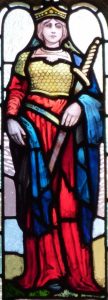Aethelflaed, Lady of the Mercians
- July 18th, 2016
- by specialcollections
- in Guest Contributors
The following post is a fine example of student research in legal history. Its author is Kaylin Oldham, a rising third-year law student and a 2013 graduate in English of the University of Kentucky. Her paper is titled “Aethelflaed, Lady of the Mercians: An Analysis of Women’s Rights in Anglo-Saxon England from the Perspective of a Warrior Queen.” The essay examines, from a legal standpoint, the extraordinary career of Aethelflaed (d. 918), daughter of Alfred the Great. Ms. Oldham’s paper was written for the class “From the Dark Ages to the Black Death: History of English Law.”
Aethelflaed, Lady of the Mercians: An Analysis of Women’s Rights in Anglo-Saxon England from the Perspective of a Warrior Queen
Aethelflaed, Lady of the Mercians, daughter of King Alfred the Great and sister of King Edward the Elder, was a heroine of Anglo-Saxon England and played a significant role in the unification of the nation. However, despite her lasting contributions to Edward’s campaigns against the Danes, the details of her life and exploits (even the year of her birth) are largely missing from the historical record.

In his twelfth-century Gesta Regum Angelorum, for example, William of Malmesbury wrote, “Aethelflaed, sister of the king and widow of Aethelred, ought not to be forgotten, as she was a powerful accession to his [Edward’s] party.”
However, the happenstance of history has ensured that her role is subject of little scholarship and review.[1] Despite this neglect, at least one modern historian has concluded that Aethelflaed “play[ed] a vital role in England during the first quarter of the tenth century.”[2] In light of her blighted reputation and the lack of historical sources concerning her, this essay examines the available record of Aethelflaed’s life in a manner that exposes the legal status of women of the time. Though Aethelflaed was royal by birth and marriage, this essay uses original sources to examine her own role in contrast to the position of the everyday Anglo-Saxon woman. Using examples from Aethelflaed’s own life, we consider how the role of one “miraculous” woman may represent the unknown achievements of less visible women.
Part I of the essay analyzes the role of family in Anglo-Saxon England and provides known biographical details about Aethelflaed’s life. Then, using those details, the essay compares Aethelflaed’s own life experiences to the laws and codes concerning women and examines the female influence on Anglo-Saxon family life. Part II scrutinizes the status of widows in Anglo-Saxon England and considers how Aethelflaed’s own widowhood acted as a catalyst for her military achievements.
